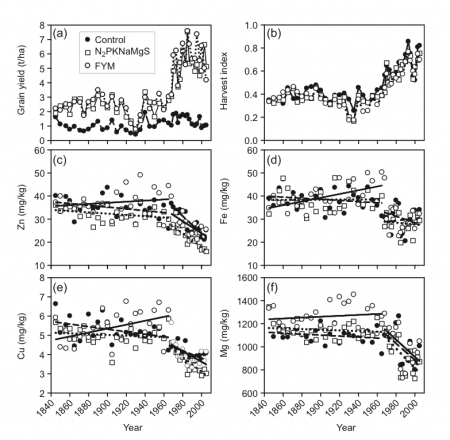- Al Jazeera discovers wild relatives.
- The Scotsman discovers the laws of heredity.
- Diana uncovers banana beer.
- Rio +20 hacks discover the cerrado.
- Indian genebank discovers the market?
- JSTOR uncovers the pistachio.
- Scottish potato farmers discover new nemesis.
Wheat has become less nutritious since the mid-1960s
![]() Following up on our recent post drawing attention to the overall decline in micronutrients in fruit and veg, here’s a 2008 paper dealing specifically with wheat. Ming-Sheng Fang and colleagues looked at levels of minerals in grain harvested from one of the longest-running agricultural experiments in the world, the Broadbalk Wheat Experiment. Not just grain, but soil too. And not just historical records — since 1843! — but a direct experiment growing an old variety alongside a modern one.
Following up on our recent post drawing attention to the overall decline in micronutrients in fruit and veg, here’s a 2008 paper dealing specifically with wheat. Ming-Sheng Fang and colleagues looked at levels of minerals in grain harvested from one of the longest-running agricultural experiments in the world, the Broadbalk Wheat Experiment. Not just grain, but soil too. And not just historical records — since 1843! — but a direct experiment growing an old variety alongside a modern one.
The paper 1 is honestly a model of clarity; anyone can read and understand it. And the conclusion is pretty straightforward too.
The concentrations of zinc, iron, copper and magnesium remained stable between 1845 and the mid 1960s, but since then have decreased significantly, which coincided with the introduction of semi-dwarf, high-yielding cultivars. In comparison, the concentrations in soil have either increased or remained stable. Similarly decreasing trends were observed in different treatments receiving no fertilizers, inorganic fertilizers or organic manure. Multiple regression analysis showed that both increasing yield and harvest index 2 were highly significant factors that explained the downward trend in grain mineral concentration.
Here’s a picture.

And here’s a final, circumspect, conclusion.
Results from the present study suggest that the Green Revolution has unintentionally contributed to decreased mineral density in wheat grain, at least in the Broadbalk Experiment. The study of Garvin et al. [9] suggests that this may also be the case for US wheat.
There are a few other papers showing very similar effects, not all of them straightforward. The general conclusion — that environmental and genetic dilution effects have reduced the concentration of many micronutrients in modern varieties — surely stands.
Nibbles: Pests & Diseases, Cichorium, Agroforestry etc, Heritage oranges, Shepherds, ITPGRFA news
- Diversity protects against pests and diseases, especially when it is needed most.
- Amateur enthusiast cracks chicory biodiversity.
- Conservation Agriculture With Trees; it’s the new big thing in Africa.
- Saving the last orange grove in Orange County from destruction.
- Shepherds of the world; a slideshow from The Guardian.
- And — Oh Boy! — you can jump through some hoops to get a newsletter on the International Treaty of Plant Genetic Reso0urces for Food and Agriculture.
Brainfood: Agronomy, Endophytes, Breadfruit morphology, Setaria genetic diversity, Yeast epigenetics, Wild rice
- Avenues to meet food security. The role of agronomy on solving complexity in food production and resource use. Wait, what, it’s not all about the breeding?
- Population studies of native grass-endophyte symbioses provide clues for the roles of host jumps and hybridization in driving their evolution. Wait, what, we have to conserve these things too now?
- Morphological diversity in breadfruit (Artocarpus, Moraceae): insights into domestication, conservation, and cultivar identification. Cool, we now have a multi-access Lucid key to help us recognize varieties.
- Geographical variation of foxtail millet, Setaria italica (L.) P. Beauv. based on rDNA PCR–RFLP. Geographic differentiation, centre in East Asia, evidence of migration, yada yada.
- Within-genotype epigenetic variation enables broad niche width in a flower living yeast. Wait, what, now we have to document the epigenome too?
- Phylogeography of Asian wild rice, Oryza rufipogon: a genome-wide view. Fancy markers come through where lesser breeds caused confusion. Two groups, clinally arranged, with the China-Indochina group close to indica, neither close to japonica. So one, Chinese, domestication event, yada yada.
Nibbles: Coconut origins, Microbe genebank, Stay-green barley, Sachs may suck, Cap in hand, Wheat information, IITA birthday, Cat art, Poppy biosynthesis, Correcting names
- Coconut origins, the quick version.
- Chile gets a bugbank.
- Stay-green barley genes located. In a genebank collection, natch. What now, a Stay-green Revolution?
- New Economist blog agnostic about Millennium Villages.
- Plant scientists call for $100 billion investment in, er, plant science.
- Wheat pedigrees online.
- IITA a youthful 45.
- Cats in Islam.
- Noscapine production in poppies is complex, but not so complex that boffins can’t figure it out.
- Want help in getting taxonomic names right? What you need is the Taxonomic Name Resolution Service. Does that mean we don’t need this any more?